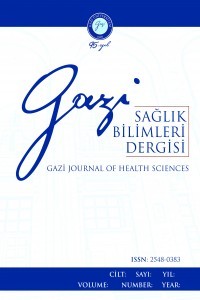Sağlıklı Genç Yetişkinlerde Akıllı Telefon Bağımlılığının Parmak Duyusu Hassasiyetine Etkisi
Akıllı telefon bağımlılığı, dominant baş parmak, genç yetişkinler, iki nokta diskriminasyonu, parmak duyusu
The Effect of Smartphone Addiction on Finger Sensitivity in Healthy Young Adults
___
- 1. Olson JA, Sandra DA, Colucci ÉS, Al Bikaii A, Chmoulevitch D, Nahas J, et al. Smartphone addiction is increasing across the world: A meta-analysis of 24 countries. Comput Hum Behav. 2022;129:107138.
- 2. Busch PA, McCarthy S. Antecedents and consequences of problematic smartphone use: A systematic literature review of an emerging research area. Comput Hum Behav. 2020;114:106414.
- 3. Alkhateeb A, Alboali R, Alharbi W, Saleh O. Smartphone addiction and its complications related to health and daily activities among university students in Saudi Arabia: A multicenter study. J Family Med Prim Care. 2020 Jul 30;9(7):3220-24.
- 4. Buctot DB, Kim N, Kim JJ. Factors associated with smartphone addiction prevalence and its predictive capacity for health related quality of life among Filipino adolescents. Child Youth Serv Rev. 2020;12:104758.
- 5. Olsen EOM, Shults RA, Eaton DK. Texting while driving and other risky motor vehicle behaviors among US high school students. Pediatrics 2013;131:e1708 15.
- 6. Hejab M. Alfawareh SJ. Smartphones usage among university students: Najran university case. Int J Acad Res. 2014;6:321 6.
- 7. Yadav, S., Chakraborty, P., Meena, L., Yadav, D., & Mittal, P. (2021). Children's interaction with touchscreen devices: Performance and validity of Fitts' law. Human Behavior and Emerging Technologies, 3( 5), 1132–40.
- 8. Umeki N, Murata J, Higashijima M. Effects of training for finger perception on functional recovery of hemiplegic upper limbs in acute stroke patients. Occup Ther Int. 2019; 2019:6508261.
- 9. Carey LM, Matyas TA. Frequency of discriminative sensory loss in the hand after stroke in a rehabilitation setting. J Rehabil Med. 2011; 43(3):257-63.
- 10. Smania N, Montagnana B, Faccioli S, Fiaschi A, Aglioti SM. Rehabilitation of somatic sensation and related deficit of motor control in patients with pure sensory stroke. Arch Phys Med Rehabil. 2003; 84(11):1692-702.
- 11. Kwon M, Kim DJ, Cho H, Yang S. The smartphone addiction scale: development and validation of a short version for adolescents. PLoS One. 2013; 8(12):e83558.
- 12. Smetaniuk P. A preliminary investigation into the prevalence and prediction of problematic cell phone use. J Behav Addict. 2014; 3(1):41-53.
- 13. Alkhateeb A, Alboali R, Alharbi W, Saleh O. Smartphone addiction and its complications related to health and daily activities among university students in Saudi Arabia: A multicenter study. J Family Med Prim Care. 2020; 9(7):3220-4.
- 14. Demirci K, Orhan H, Demirdas A, Akpına Demirci K, Orhan H, Demirdas A, et al. Validity and reliability of the Turkish version of the Smartphone addiction scale in a younger population. Bulletin Clin Psychopharmacol 2014; 24:226‐34.
- 15. Yoon J‐O, Kim J‐S. The effects of gait with use of smartphone on repositioning error and curvature of the lumbar spine. J Phys Ther Sci 2015; 27:2507.
- 16. Meo SA, Al‐Dreess AM. Mobile phone related hazards and subjective hearing and vision symptoms in the Saudi population. Int J Occup Med Env Health. 2005; 18:45‐9.
- ISSN: 2548-0383
- Yayın Aralığı: Yılda 3 Sayı
- Başlangıç: 2015
- Yayıncı: Gazi Üniversitesi
HEMŞİRELERİN İŞYERİ ŞİDDETİNE MARUZ KALMA DURUMLARI İLE İŞ DOYUMLARI VE İŞTEN AYRILMA EĞİLİMLERİ
Nigar ÜNLÜSOY DİNÇER, Refia Selma GÖRGÜLÜ, Aslıhan BOYACIOĞLU
Multiple Sklerozlu Hastalarda El Mental Rotasyon Görevi
Büsra CANDİRİ, Engin RAMAZANOĞLU, Burcu TALU, Mehmet TECELLİOĞLU
Seval AĞAÇDİKEN ALKAN, Özge İŞERİ, Meryem KIRMIZI
ADÖLESANLARDA KRONOTİPE GÖRE ÖĞÜN ZAMANI VE BESİN TERCİHLERİNİN İNCELENMESİ
Gebe Kadınların Sağlık Uygulamaları Ve Etkileyen Faktörlerin İncelenmesi
Persistent Postural Perceptual Dizziness Tedavisinde Vestibüler Rehabilitasyonun Etkisi
Besin Ambalajlarında Sürdürülebilirliğe İlişkin Logo Varlığının İncelenmesi: İtalya Örneği
Sağlıklı Genç Yetişkinlerde Akıllı Telefon Bağımlılığının Parmak Duyusu Hassasiyetine Etkisi
Doğaç KARAGÜVEN, İlker ÇETİN, Alper KAYA, Berk GÜÇLÜ, Burak AKAN
